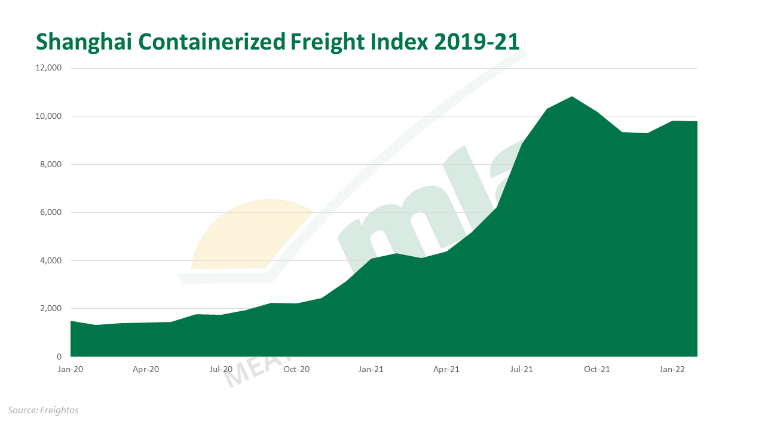Outlook for exporters remains strong

Figure 1: Shanghai Containerized Freight Index (SCFI).
At the start of the year, most freight forwarders and exporters expected 2022 to be a year of recovery for the industry, with ports cleared and reliability increasing.
After the unprecedented 393% increase in the Shanghai Containerized Freight Index (SCFI) over 2020–2021, spot rates for containerized freight stabilised in December and January, and key indicators suggested a slide in prices through 2022.
Unfortunately, unforeseen events have further disrupted the supply chain both in Australia and around the world, keeping prices high and adding to the difficulty faced by exporters.
The most important disruptor this year has been flooding in the southeast over February and March.
This has had impacts throughout the supply chain, with flooded roads meaning producers were unable to transport cattle, while processors were unable to maintain consistent power due to flood-related outages. The flooding had a particularly acute impact on red meat export as the Port of Brisbane flooded, closing the main beef exporting port for several days and limiting capacity for several weeks afterwards.
This has significantly impacted exports in March, with preliminary data suggesting red meat exports are 29% lower in March 2022 than March 2021. Fortunately, the Port of Brisbane has resumed service relatively quickly and this is unlikely to impact exports in the long term.
Global events have also affected the outlook of freight. In Europe, Russia’s invasion of Ukraine has disrupted supply chains across Eurasia and driven up oil prices, increasing costs and adding to instability across the system.
As Russia is a major overland transit route between Europe and Asia, the conflict has made overland shipment of goods difficult or impossible in some cases. Additionally, the Russian decision to close its airspace to most airlines has increased costs and travel times of air freight. This, alongside the increased price of oil, has increased uncertainty around the ability to ship goods and has kept prices at all-time highs.
Despite this, the outlook for exporters remains strong. Tight red meat supplies globally are keeping prices high, dulling the impact of increased freight rates, while an influx of new, high-capacity container ships is expected to begin service in the second half of the year and in 2023.
Broadly speaking, the fundamentals of shipping are improving. Prices are likely to hold steady or decline, while reliability is likely to slowly improve over the year. This does not necessarily mean a return to the cheap, frequent service seen before 2020, but steady improvements are on the horizon.



